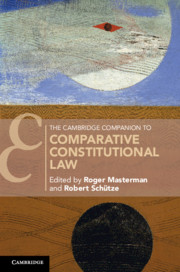Book contents
- Reviews
- The Cambridge Companion to Comparative Constitutional Law
- Cambridge Companions to Law
- The Cambridge Companion toComparative Constitutional Law
- Copyright page
- Contents
- Notes on Contributors
- Acknowledgements
- Table of Cases (Selection)
- Abbreviations
- Introduction
- Part I Theoretical Foundations
- Part II Historical Experiences
- 3 The United Kingdom Constitution
- 4 French Constitutional Law
- 5 US Constitutional Law and History
- 6 The Constitution of the Republic of India
- 7 The Constitution of China
- Part III Constitutional Principles
- Part IV State Institutions
- Part V Transnational Constitutionalism
- Index
- References
6 - The Constitution of the Republic of India
from Part II - Historical Experiences
Published online by Cambridge University Press: 30 September 2019
- Reviews
- The Cambridge Companion to Comparative Constitutional Law
- Cambridge Companions to Law
- The Cambridge Companion toComparative Constitutional Law
- Copyright page
- Contents
- Notes on Contributors
- Acknowledgements
- Table of Cases (Selection)
- Abbreviations
- Introduction
- Part I Theoretical Foundations
- Part II Historical Experiences
- 3 The United Kingdom Constitution
- 4 French Constitutional Law
- 5 US Constitutional Law and History
- 6 The Constitution of the Republic of India
- 7 The Constitution of China
- Part III Constitutional Principles
- Part IV State Institutions
- Part V Transnational Constitutionalism
- Index
- References
Summary
The Constitution of India, adopted in 1949 and still in force today, was one of the earliest post-colonial Constitutions. Where the constitutional systems of most other newly independent states of the 1960s and 1970s have been marked by revolution, constitutional repeal and suspension, the Indian Constitution is remarkable for its durability. In fact, there are only a handful of states, with or without a colonial history, whose Constitutions have proved more resilient. The Indian Constitution is also the longest Constitution in the world, with the original draft consisting of 395 articles, eight schedules and a huge amount of administrative detail. There have also been 101 Amendments to the Constitution.
- Type
- Chapter
- Information
- The Cambridge Companion to Comparative Constitutional Law , pp. 141 - 170Publisher: Cambridge University PressPrint publication year: 2019

